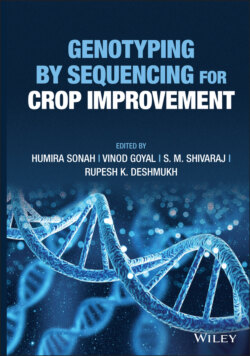Читать книгу Genotyping by Sequencing for Crop Improvement - Группа авторов - Страница 53
2.2.2.2 Allelic Detection 2.2.2.2.1 Allele‐Specific Primer‐based SNP Genotyping‐Fluidigm
ОглавлениеFluidigm EP1 is the fast, cost‐effective, and efficient system for medium‐throughput SNP genotyping. This system works on a principle of locus‐specific primer‐based PCR amplification and genotyping (similar to Taqman chemistry). The system incorporates a nanofluidic chip, also known as integrated fluid circuit (IFC) which consists of a network of fluid lines from sample and assay inlet, nanoflex valves, and reaction chambers. This technology has the potential to perform up to 9216 independent TaqMan reactions in a single experiment (Maurice Chan et al. 2011). The nanoflex valve, which is composed of elastomeric rubber, is used to regulate the flow of fluids in the IFC by deflecting under pressure and creating a tight seal is the cornerstone of the IFC.
Figure 2.3 Illustration of various steps involved in the generation of RAD‐based SNP marker generation. (a) Ligate P1 adopter to digested genomic DNA. (b) Poor barcoded sample and shear. (c) Ligate P2 adopter to sheared fragments. (d) selective amplification of RAD tags.
Source: The figure is reproduced from Baird et al. (2008) available with Creative Commons Attribution License (CC BY).
An IFC is primed in the IFC Controller before loading of samples and assays. The IFC controller pressurizes the control lines and closes the interface valves. After priming of IFC, samples and Taqman assays are loaded into the IFC and then again put into the controller for the mixing of sample and assays into the reaction chambers. In the loading process, on application of pressure, fluid from the sample inlets and assay inlets are pushed into the corresponding fluid lines. The chip utilizes carry over slug design (CS) which allows precise metering and mixing of fluids in a reaction (Unger et al. 2000) chamber (nanolitres of samples and assays are used in a reaction). The loading process takes 45 minutes in the controller and after that, the IFC is being loaded into the standalone PCR and the reaction starts in reaction chambers by thermal cycling in presence of fluorophore‐containing probes. After completion of PCR, the data are acquired in the EP1 fluorescence system and the data analysis is done using bioinformatic tools and Software.
The processing of plant samples, i.e. DNA requires preamplification, which is done using specific‐target amplification and locus‐specific primers. After diluting the preamplified products with distilled water, PCR amplification with allele‐specific primers is carried out (Kishora et al. 2020). During PCR amplification, two fluorogenic probes corresponding to one of the two alleles in a biallelic SNP are used to probe the SNP site. The probes are made up of a fluorescent reporter dye attached to the probe's 5′ end and a nonfluorescent quencher attached to the probe's 3′ end. The reporter dye's fluorescence is muted when the probe is intact because the reporter dye is close to the quencher. The probe anneals selectively to a complementary sequence during PCR. This causes the probe to cleave, releasing the reporter dye, resulting in increased fluorescence with each PCR cycle. This increase in fluorescence occurs only if the target sequence is complementary to the probe and is amplified during PCR (Seeb et al. 2009).
